TIMARU STAR II: NAN AUCTION 2006: CAT BAR II
COME ONE COME ALL, and see what we've got this year: a Fully Braided Rawhide Button Bridle in one-ninth Traditional scale. For all you serious model tack collectors out there, this is a piece to reckon with! Built by one of the top model tackmakers in the hobby as a one-of-a-kind anniversary piece, 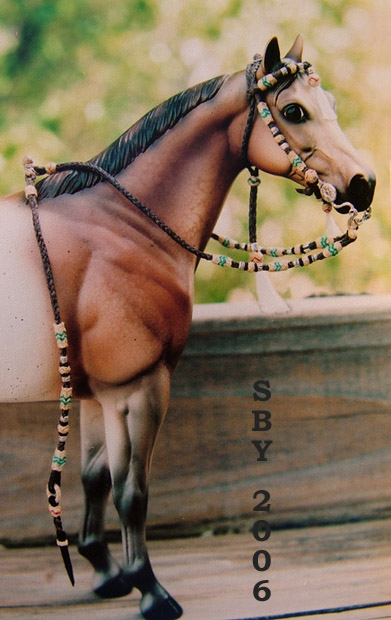 this outstanding bridle combines rare talent and workmanship with stunning design. The colors of deep brown and light bleached rawhide contrast with the turquoise and Indian red interweaves; white horsehair tassels adorn the slip-fashion throatlatch and charming tied curb strap, which IS adjustable! Silver beads from Hill Tribes Silver combine with the handbraided buttons and blend with the glittering Nickel-plated bit (Rio Rondo's W408) and the handtwisted stainless steel crown buckle. This bridle was created for the Ideal Stock Horse mold.
this outstanding bridle combines rare talent and workmanship with stunning design. The colors of deep brown and light bleached rawhide contrast with the turquoise and Indian red interweaves; white horsehair tassels adorn the slip-fashion throatlatch and charming tied curb strap, which IS adjustable! Silver beads from Hill Tribes Silver combine with the handbraided buttons and blend with the glittering Nickel-plated bit (Rio Rondo's W408) and the handtwisted stainless steel crown buckle. This bridle was created for the Ideal Stock Horse mold. 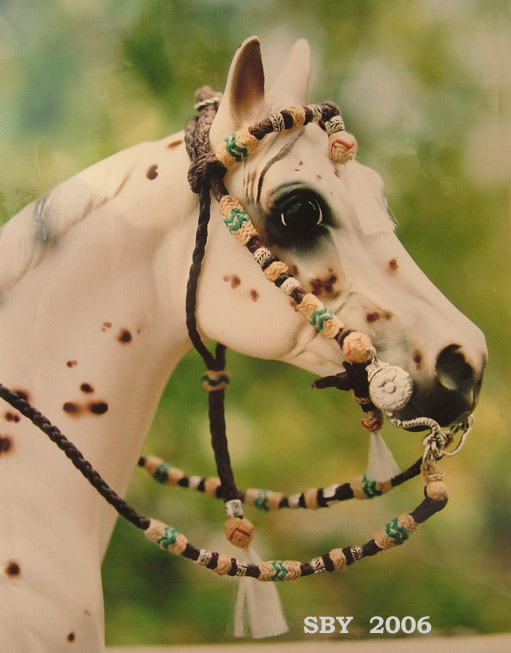 The headstall will fit Smart Chic Olena, Zippo Pine Bar, and others of their size; because of these horses' longer rein length, it is recommended that rein chains be added for them -- which the TSII will be glad to do if desired by the winner. You CAN change bits: those are button and loop fasteners at the bithead. The material of the 'straps' is nylon sinew and waxed linen thread: this can withstand a lot more stress than the old braided leather lace! This bridle would be suitable for Western Pleasure and Trail... although given its pedigree, one proper use would be as a miniature trophy set awarded to the most outstanding horse of the show, displayed in a scratch-built glass case...!
The headstall will fit Smart Chic Olena, Zippo Pine Bar, and others of their size; because of these horses' longer rein length, it is recommended that rein chains be added for them -- which the TSII will be glad to do if desired by the winner. You CAN change bits: those are button and loop fasteners at the bithead. The material of the 'straps' is nylon sinew and waxed linen thread: this can withstand a lot more stress than the old braided leather lace! This bridle would be suitable for Western Pleasure and Trail... although given its pedigree, one proper use would be as a miniature trophy set awarded to the most outstanding horse of the show, displayed in a scratch-built glass case...!
It has been more than twenty years since I started making scale-model rawhide braided bridles. I have been very fortunate in that the very first one is still with me, known today as Cat Bar's Bridle. I set out to celebrate those twenty-plus years, and my love of braidwork in miniature (by now a habit for NAN), by choosing the same color scheme, scale, and overall design as that long-ago piece. 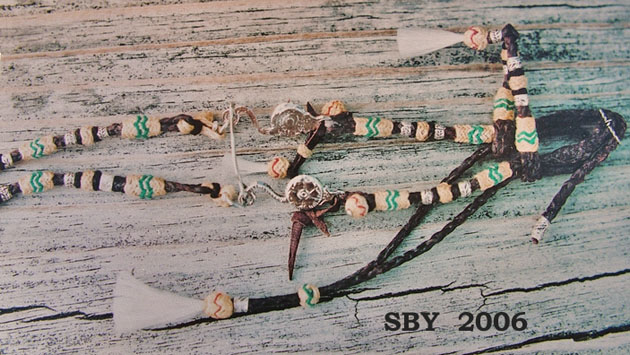 But I threw in everything those years had taught me about detail and materials... and I had a recent button discovery to inspire me. Nothing gets a tackmaker going like a new idea... I decided to call it "Cat Bar II."
But I threw in everything those years had taught me about detail and materials... and I had a recent button discovery to inspire me. Nothing gets a tackmaker going like a new idea... I decided to call it "Cat Bar II."
The main features on Cat Bar II are 18 part 8 bight braided rawhide buttons with three rings of interweave in red cotton. This so-called 18 part is itself a 9 part 4 bight with 5 rings of self-colored interweave done in Grant's so-called Herringbone pattern. For years I'd been ignoring Plate 64 in Grant's book, Leathing Braiding, because I thought it was a simple two rings of interweave done on a 7 part 6 bight: using what I and everybody else (Gail Hought, Robert Woolery) called the Herringbone... and had been for years. Imagine my surprse when it turned out to be something else: something different: a different approach and pattern. That something else carried the same name, but managed to pack two [interweave] rings into the button I'd previously been able to fit only one. For my previous two rings, it fit three; for my previous four, it fit five; and so forth. Confused?? You bet!! "A rose by any other name..." With my formula conventions in tatters but my braider's soul thrilled, I went ahead and explored this new method to my heart's content. It made a thicker and more detailed button, with a pronounced 'herringbone' series of waves or chevrons set at 90 degrees to the long axis of the button. As I mature as a braider and as a modeller, leaning towards larger horses for more room and more detail, this discovery seems more than coincidence. The blue interweaves on Cat Bar II (and the red ones on the Pasadena bridle) were done with a formula I worked out for myself -- the first time I had done so -- a notable step along this path that the Timaru Star II has chosen, and is following, with so much joy.
The Story of Cat Bar's Bridle
Once I sat down and dug up the notes, I was amazed! swept away! and the simple sales paragraph swelled up into a real magazine article. I've always wanted to tell this story, but until I could narrow it down to a single piece of tack, it seemed overwhelming. 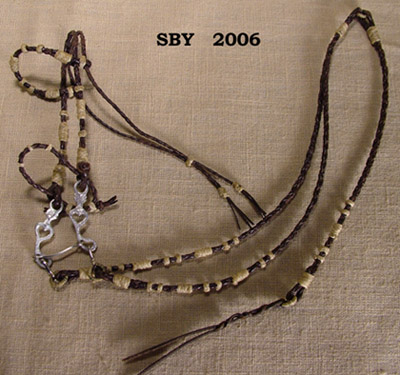 However, having gotten started with the above, it is my wish to share with you the roots of one of my favorite pieces of tack. This article will discuss the origin of Cat Bar's bridle, list the FB RBs (fully braided rawhide bridles, pronounced 'fib ribs') that followed it and outline the evolution of the skill that produced them, touch upon care and cleaning, and hopefully inspire you: not just to collect, but to appreciate and understand, these crown jewels of the model horse tack collector. Beyond appreciation, if this should show you that you can be a tackmaker too, I will have achieved my goal.
However, having gotten started with the above, it is my wish to share with you the roots of one of my favorite pieces of tack. This article will discuss the origin of Cat Bar's bridle, list the FB RBs (fully braided rawhide bridles, pronounced 'fib ribs') that followed it and outline the evolution of the skill that produced them, touch upon care and cleaning, and hopefully inspire you: not just to collect, but to appreciate and understand, these crown jewels of the model horse tack collector. Beyond appreciation, if this should show you that you can be a tackmaker too, I will have achieved my goal.
The original inspiration for my first-ever fully braided rawhide bridle is lost to history. The best source of notes about it was mistakenly thrown out in 1988. All we have to go on is secondary sources in other notebooks, TSII Master Order lists, and of course the bridle itself: and as it turns out, that is enough. A note on terminology: I use "fully braided" to describe a piece in which the straps are braided [round-braided] as well as the buttons.
Peering back into the dark, my memory of triggering inspiration -- the vision that starts nearly every piece of tack -- is the sense that a braided rawhide bridle should be dark brown with light-colored buttons: a picture of that combination, of that texture, remains in my mind. Looking hard through both of the braid reference books I had at the time -- Grant's Leather Braiding, and Grant & Rice's How to Make Cowboy Horse Gear -- I find no such thing. No real tack was consulted or known; I did not visit a tack shop; I had no other books, pictures or clippings. There was no other piece of model tack to inspire me, as so often happens. Where did this vision come from?
In August of 1985, the date on the earliest photographs of Cat Bar's bridle, I was living in an apartment in Fort Collins, Colorado, with a roommate, running a mail-order business with great pride and glee, blithely ignorant of the fact I was not making a living. This was the height of my 'glory years': the years between graduation (fall/winter 1982) and engagement with George Young (early spring 1987). The TSII went full-time in January of 1983, and with some changes, it has been that way ever since. The TSII was started in the summer of 1979, so by 1985 it had been a going concern for 6 years... long enough to build up a clientele and see the hobby through a couple of waves of change. In the mid-eighties the king of the show ring was the remake.
There may have not been any direct inspirations for Cat Bar's bridle, but there were indirect ones. All along I had been offering 4-strand braided Rope Halters, and bosal hackamores using sinew, slit-braided lace and braided string. 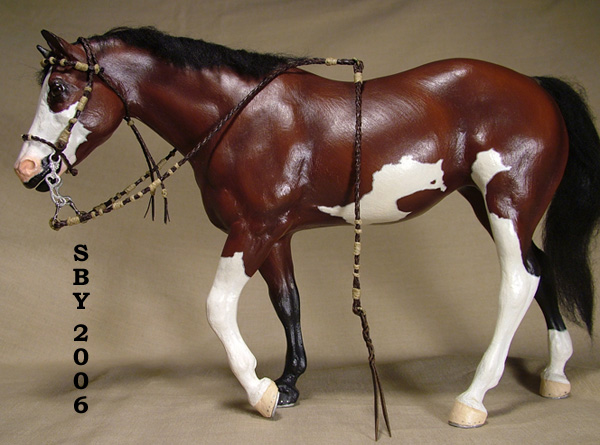 Since 1982 the TSII pricelist had offered "Mystery Braid" bridles, with intricately braided brow- and nosebands. Knowing how to do this spectacular trick in miniature was a great source of pride; for this trick to be done in narrow lace (3/32") the lace had to be cut lengthwise in thirds, by hand. Being able to do this impossibly tiny thing must have pushed me on to trying to cut narrow lace in QUARTERS lengthwise -- to make it as small as possible without breaking. And of course the lace I used, and was familiar with, was the dark brown. The other material I was very familiar with was the waxed linen thread, in its three colors of black, brown and white. The white was the closest material, by far, that I had to real rawhide. (And thus may have dictated the color choice.) I knew that REAL rawhide could not be used (it shredded into fibers at that scale) and the trick of using cotton thread for the buttons would not be discovered until 1991, six years down the road. Why did such a discovery take me so long? I can only speculate that I was a very stubborn artist. However, to have narrow vision is also to have very great artistic freedom, within safe walls. I was going through a particularly turbulent time that year, chosing between two boyfriends as different as clay and gold -- indeed choosing whether to stay single or not. (But I am not at all sure this had any significance.) For a stunning coincidence, however, I have realized that my grandmother, Dorothy Gifford Bensema, passed away in May of 1985; and it was HER spool of heavy white thread, which came into my hands, which was used on that FB RB in 1991.
(NOTE that in the years since, I have seen other model tackmakers actually use real rawhide for braided bridles in Traditional scale. The trick appears to be goat rawhide skived very thin, and to use the grain side.)
Since 1982 the TSII pricelist had offered "Mystery Braid" bridles, with intricately braided brow- and nosebands. Knowing how to do this spectacular trick in miniature was a great source of pride; for this trick to be done in narrow lace (3/32") the lace had to be cut lengthwise in thirds, by hand. Being able to do this impossibly tiny thing must have pushed me on to trying to cut narrow lace in QUARTERS lengthwise -- to make it as small as possible without breaking. And of course the lace I used, and was familiar with, was the dark brown. The other material I was very familiar with was the waxed linen thread, in its three colors of black, brown and white. The white was the closest material, by far, that I had to real rawhide. (And thus may have dictated the color choice.) I knew that REAL rawhide could not be used (it shredded into fibers at that scale) and the trick of using cotton thread for the buttons would not be discovered until 1991, six years down the road. Why did such a discovery take me so long? I can only speculate that I was a very stubborn artist. However, to have narrow vision is also to have very great artistic freedom, within safe walls. I was going through a particularly turbulent time that year, chosing between two boyfriends as different as clay and gold -- indeed choosing whether to stay single or not. (But I am not at all sure this had any significance.) For a stunning coincidence, however, I have realized that my grandmother, Dorothy Gifford Bensema, passed away in May of 1985; and it was HER spool of heavy white thread, which came into my hands, which was used on that FB RB in 1991.
(NOTE that in the years since, I have seen other model tackmakers actually use real rawhide for braided bridles in Traditional scale. The trick appears to be goat rawhide skived very thin, and to use the grain side.)
Cat Bar herself came into my life in July, 1985, as a trade for a parade set with the artist Chris Cook (today, Chris Nandell). She was an expensive horse for me (priced at $80 at the time) and would have deserved the very best I could make. Written diary evidence suggests the end of May for actual creation of the bridle. 8505.12: "[set aside time for] work on own tack." 8505.18: "work on braided bridle." 8505.26: "braided bridle $30" - a note to update my pricelist, and a clear sign of a new technique!
I remember I skived lace very thin and cut it as narrowly as I could, and hot-oiling it (soaking it in melted Dr. Jackson's until the color changed and no more oil could be absorbed). The laces were 4-strand-round-braided and then rolled by hand on the Masonite, which smoothed and compacted the work. The original bit was made of 20-ga. galvanized steel wire, to which I must have added a mouthpiece shortly thereafter -- Cat Bar was, and remains, my only open-mouth model horse.
The device by which the bit fastens to the cheeks is deceptively simple. A loop of the thin lace was inserted into the braid; the 4 strands of the ends were done up in a "Turk's Head" finishing knot, Grant Plate 15. The loop fits over the finishing knot, itself making a loop that holds the bit. Curiously, written records of tack orders reveal three sets of 'fancy braided hobbles and riata' that fall of 1985, before the pricelist mentions them -- the first one at the end of July, purchased by none other than Marney Walerius. 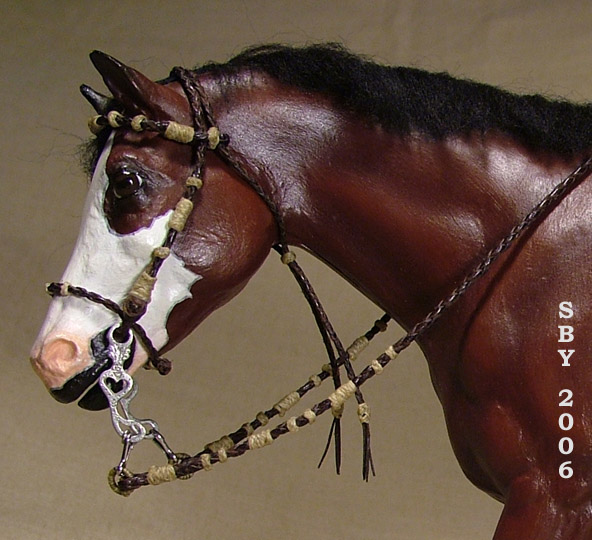 I suspect I practiced on these hobbles, with their attendant end-knots but lack of braided buttons (they were decorated only with crimps), gaining experience in working with the notoriously difficult braided leather I had created. Per inch, that stuff had more sheer EFFORT in it than anything I'd ever made before... it vibrated with psychic effort. I hope you tackmakers out there know what I mean. Even today I can find the stumps and scraps of braided leather leftovers from that time, preserved in ziplockies, buried deep in the drawer labelled "Never-to-be-Used: Freaks of Nature & Other Strange Things."
I suspect I practiced on these hobbles, with their attendant end-knots but lack of braided buttons (they were decorated only with crimps), gaining experience in working with the notoriously difficult braided leather I had created. Per inch, that stuff had more sheer EFFORT in it than anything I'd ever made before... it vibrated with psychic effort. I hope you tackmakers out there know what I mean. Even today I can find the stumps and scraps of braided leather leftovers from that time, preserved in ziplockies, buried deep in the drawer labelled "Never-to-be-Used: Freaks of Nature & Other Strange Things."
Of course the crowning jewel was the buttons themselves. I was learning from only one book, Grant's Leather Braiding. I remember I called the buttons 'Plate 53,' 'Plate 52,' 'Plate 50' and 'Plate 47,' these being the names of the illustrated pages of his instruction book. These names have persisted down through the years and are still at the back of my conscience. I used the single strand of white waxed linen thread, unraveled from the spool-cord of 5 strands, just as I had been using this same thread since the very beginning of my tackshop, for stitching. At this stage there was no gluing or coating, and certainly no dyeing. Then as now, the buttons were woven with a needle, and the ends fixed by piercing through the core after having passed under a few laps. Given the scale, often these last steps can be combined.
I remember a massive effort to understand the braiding of the buttons. Grant's method was purely analog. Once I had more or less memorized the drawings (deep understanding would not come until 10 years later, when I discovered Woolery's formulas), I became aware of a significant defect in my work. The waxed linen thread was so soft it mushed into invisibility when pulled tight -- even during the normal braiding. All that work to get the braid laps to show, and they didn't!! I was good and frustrated, but stuck to it until the whole bridle, reins and all, was done. This was in the days when a single new tackmaking trick was tried out with an entire piece... and tenacity was a large part of what defined me. It was normal, then and now, for such an important, large, new and promising technique to be experimented with on a piece I would keep: a process called keeping the prototype. I have known tackmakers who do not feel they can keep their important prototypes; all I can say is I'm sorry, but you will probably regret that some day. Keeping them gives value to your effort and clues to how to improve future pieces. It might also, in some cases, establish the roots of a museum. In ANY case I hope you can see how important it is to DOCUMENT and SIGN (if possible -- none of my early FB RBs are signed!) your important pieces of model tack work.
Listing of TSII FB RBs, 1985 - 2005
A brief overview of fully braided bridles created by the TSII in that twenty-year span between 1985 and 2005, broken down into more-or-less five-year sections, would look like this: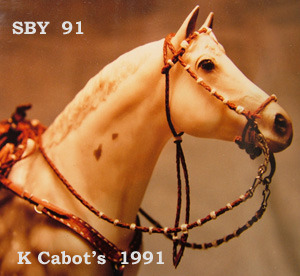
1985 - 1991:
Eight other braided-lace and waxed linen thread FB RBs through March of 1991. One white "buckstitching" bridle made in 1987 for myself. The original owners are recorded as: Rena George, E. Bouras, C. McKeever, W. Nielsen, D Jenkins, J. Froelich, K. Wells, J Barrett. Total, 9.
1991 - 1994:
White cotton thread first used for buttons with Kate Cabot's FB RB in August of 1991. Shortly after (Feb. 1992) colored thread (embroidery floss) experimented with for buttons with Ivy Olensky's, which was also the first Classic scale. K. Cabot, N. Hunter, I. Olensky, V. Cary, K. Kiley, C. Robertson, J Raymond. Total, 7.
1995 - 2000:
W. Galbreath (Dec 1994): first use of artificial sinew for a Peruvian Paso bridle.
K. Bleeker (Feb 1995): last braided-lace FB RB and first with blue embroidery floss buttons.
Self (July 1995): Malaguena's great milestone, the first artificial sinew "miniature rawhide" fully braided bridle, also notable for its single interweaves - it's the one I learned how on. Note that other people's bridles are named after the customer, while ones I made for myself are named after horses. (NO-ooo-oo, I do NOT have a source for that fabulous bit; don't think I haven't tried!) Flat braid (California braid), much easier to make, made its entrance in 1995.
R Nikolaidis (1995): second artificial sinew rawhide color FB RB, like Malaguena's but with homemade bit.
C Day (Sept 1996)
P Beard (Oct 1996): the one on the back of the Guide.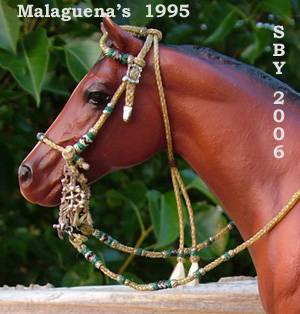
(Jan 1997): black sinew FB RB with red, in the NAN Auction of that year.
E Harvey (July 1997)
R Rizzo (Aug 1997): first black sinew with blue sinew buttons.
Self (Aug 1997): a dental-floss white FB RB with black, sinew-yellow and red buttons.
R Nikolaidis (Jan 1999): brown sinew one with red, white and sinew-yellow buttons.
Total, 11.
It should be noted that towards the end of this time, the elaborateness of TSII headgear that featured braidwork but was not "fully braided", matched and in some cases passed the FB RBs. Examples of this are the Billy Royal bridle of 1997 and Tubb's flat braid curb bridle & breastcollar of 1999.
2000 - 2005:
The turn of the century started out with a bang with Emma Harrison's Braided Weymouth, made with round-braided sinew and thus counted in this survey! The trend of improvements continued with B. Campbell's great Broken Heart copy (July 2000), upon which I discovered smaller gauge thread (and first initialed the bit); my own Butterminx bridle which was (and remains) the only purely sinew FB RB ever built (Nov 2000); and several other FB RBs which explored color in new ways (Bouras' of 2000, Rappleyea's of 2002, and Sydor's Mint Chocolate Chip of 2002 [both green]). M Hallam (June 2003): sinew FB RB with tri-color buttons of floss in caramel tones. If that were not enough, these years saw the rise of the Peruvian Paso sets, which are essentially two pieces of fully braided sinew headgear EACH... and I've made FIVE of them so far!! The trend towards elaboration in other headgear continued, to the point where they were drowning out the FB RBs in the Grey Scrapbook. An outstanding example is Partee's Braided Horsehair bridle (Oct 2005), a very difficult technology. Although it includes braided sinew (and as much work as any), we will not count it in this survey, because the straps of the bridle are not round-braided. The total FB RB count for these years, not including the Peruvians, stands at 8.
Thus the total number of fully braided rawhide bridles built by me between 1985 (Cat Bar's) and 2006 (Cat Bar II's) stands at 9 + 7 + 11 + 8, or 35. Less than three dozen, not counting either Cat Bar. In pure numbers, that shows how rare they are: 37 for twenty years works out to less than two per year. Investors, take note!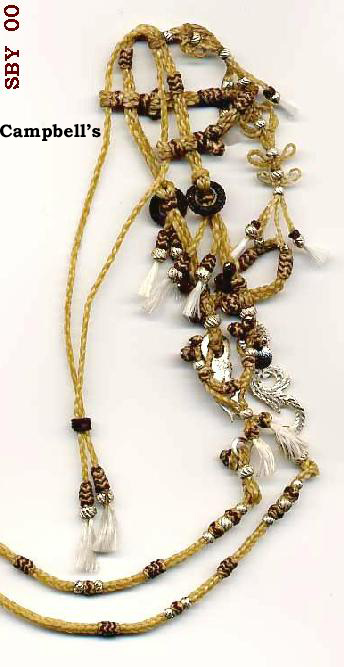
Care & Feeding
I want to end this article with a short discusson on care for miniature braidwork.
I first noticed problems with Malaguena's bridle in about 2 years after it was made. The brass crimps started greening up, the coating used on the buttons was thickening (ultimately it would grey), and the entire bridle was dusted with minute green speckles of the infamous copper sulfate, "verdigris green." No other FB RB I have kept has behaved quite so badly! making me grump that older is not better. I postulate that during the braiding of Malaguena's, copper dust from the filing of the crimps got into the sinew, and has since reacted with traces of sweat on the sinew. I know of no way to clean the speckles off. If you always wash your hands before handling these pieces, much trouble would be saved. However, I often do not --! Since the majority of braided-sinew tack is made from wax-coated nylon fibres (artificial sinew) the single biggest enemy is dust, which the wax attracts. Humidity does not seem to be a problem... unless, of course, you have a house flood. Even then I think a piece made from braided nylon would not suffer too badly; at worst, the cotton-thread buttons could be replaced. Regular dusting can be accomplished quite effectively with a dry artist's paint brush.
Silver polishing deserves a whole article... I use a moistened Q-tip and commercial silver polish ("Wright's Copper Cream"), and more Q-tips to clean up the tack afterwards. I also use a jeweller's file to clean places I can't reach otherwise. Using a cloth, i.e. Sunshine Cloth, is NOT recommended, because of the possibility of 'polishing' the areas to the sides of the silver buttons, which would dirty and destroy the braidwork.
Miniature braidwork is like any other model tack: it only needs to be kept clean and dry and safe from dust. Safe from sunlight is a personal choice: wise but difficult: weigh against ease of use. In my experience, the chances of a piece being LOST are much greater than chances of damage from long-term environmental changes. Braidwork does Not need to be oiled or greased. Once dirty, alas, I find NO way of cleaning off that 'grey gook' that human hands seem to deposit on the sinew and thread.
Make another bridle.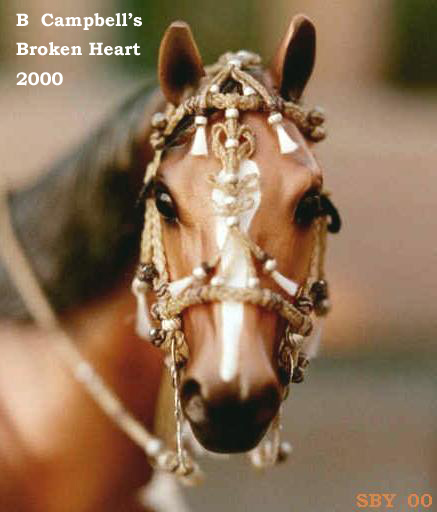
 this outstanding bridle combines rare talent and workmanship with stunning design. The colors of deep brown and light bleached rawhide contrast with the turquoise and Indian red interweaves; white horsehair tassels adorn the slip-fashion throatlatch and charming tied curb strap, which IS adjustable! Silver beads from Hill Tribes Silver combine with the handbraided buttons and blend with the glittering Nickel-plated bit (Rio Rondo's W408) and the handtwisted stainless steel crown buckle. This bridle was created for the Ideal Stock Horse mold.
this outstanding bridle combines rare talent and workmanship with stunning design. The colors of deep brown and light bleached rawhide contrast with the turquoise and Indian red interweaves; white horsehair tassels adorn the slip-fashion throatlatch and charming tied curb strap, which IS adjustable! Silver beads from Hill Tribes Silver combine with the handbraided buttons and blend with the glittering Nickel-plated bit (Rio Rondo's W408) and the handtwisted stainless steel crown buckle. This bridle was created for the Ideal Stock Horse mold.  The headstall will fit Smart Chic Olena, Zippo Pine Bar, and others of their size; because of these horses' longer rein length, it is recommended that rein chains be added for them -- which the TSII will be glad to do if desired by the winner. You CAN change bits: those are button and loop fasteners at the bithead. The material of the 'straps' is nylon sinew and waxed linen thread: this can withstand a lot more stress than the old braided leather lace! This bridle would be suitable for Western Pleasure and Trail... although given its pedigree, one proper use would be as a miniature trophy set awarded to the most outstanding horse of the show, displayed in a scratch-built glass case...!
The headstall will fit Smart Chic Olena, Zippo Pine Bar, and others of their size; because of these horses' longer rein length, it is recommended that rein chains be added for them -- which the TSII will be glad to do if desired by the winner. You CAN change bits: those are button and loop fasteners at the bithead. The material of the 'straps' is nylon sinew and waxed linen thread: this can withstand a lot more stress than the old braided leather lace! This bridle would be suitable for Western Pleasure and Trail... although given its pedigree, one proper use would be as a miniature trophy set awarded to the most outstanding horse of the show, displayed in a scratch-built glass case...!
 But I threw in everything those years had taught me about detail and materials... and I had a recent button discovery to inspire me. Nothing gets a tackmaker going like a new idea... I decided to call it "Cat Bar II."
But I threw in everything those years had taught me about detail and materials... and I had a recent button discovery to inspire me. Nothing gets a tackmaker going like a new idea... I decided to call it "Cat Bar II."
 However, having gotten started with the above, it is my wish to share with you the roots of one of my favorite pieces of tack. This article will discuss the origin of Cat Bar's bridle, list the FB RBs (fully braided rawhide bridles, pronounced 'fib ribs') that followed it and outline the evolution of the skill that produced them, touch upon care and cleaning, and hopefully inspire you: not just to collect, but to appreciate and understand, these crown jewels of the model horse tack collector. Beyond appreciation, if this should show you that you can be a tackmaker too, I will have achieved my goal.
However, having gotten started with the above, it is my wish to share with you the roots of one of my favorite pieces of tack. This article will discuss the origin of Cat Bar's bridle, list the FB RBs (fully braided rawhide bridles, pronounced 'fib ribs') that followed it and outline the evolution of the skill that produced them, touch upon care and cleaning, and hopefully inspire you: not just to collect, but to appreciate and understand, these crown jewels of the model horse tack collector. Beyond appreciation, if this should show you that you can be a tackmaker too, I will have achieved my goal.
 Since 1982 the TSII pricelist had offered "Mystery Braid" bridles, with intricately braided brow- and nosebands. Knowing how to do this spectacular trick in miniature was a great source of pride; for this trick to be done in narrow lace (3/32") the lace had to be cut lengthwise in thirds, by hand. Being able to do this impossibly tiny thing must have pushed me on to trying to cut narrow lace in QUARTERS lengthwise -- to make it as small as possible without breaking. And of course the lace I used, and was familiar with, was the dark brown. The other material I was very familiar with was the waxed linen thread, in its three colors of black, brown and white. The white was the closest material, by far, that I had to real rawhide. (And thus may have dictated the color choice.) I knew that REAL rawhide could not be used (it shredded into fibers at that scale) and the trick of using cotton thread for the buttons would not be discovered until 1991, six years down the road. Why did such a discovery take me so long? I can only speculate that I was a very stubborn artist. However, to have narrow vision is also to have very great artistic freedom, within safe walls. I was going through a particularly turbulent time that year, chosing between two boyfriends as different as clay and gold -- indeed choosing whether to stay single or not. (But I am not at all sure this had any significance.) For a stunning coincidence, however, I have realized that my grandmother, Dorothy Gifford Bensema, passed away in May of 1985; and it was HER spool of heavy white thread, which came into my hands, which was used on that FB RB in 1991.
(NOTE that in the years since, I have seen other model tackmakers actually use real rawhide for braided bridles in Traditional scale. The trick appears to be goat rawhide skived very thin, and to use the grain side.)
Since 1982 the TSII pricelist had offered "Mystery Braid" bridles, with intricately braided brow- and nosebands. Knowing how to do this spectacular trick in miniature was a great source of pride; for this trick to be done in narrow lace (3/32") the lace had to be cut lengthwise in thirds, by hand. Being able to do this impossibly tiny thing must have pushed me on to trying to cut narrow lace in QUARTERS lengthwise -- to make it as small as possible without breaking. And of course the lace I used, and was familiar with, was the dark brown. The other material I was very familiar with was the waxed linen thread, in its three colors of black, brown and white. The white was the closest material, by far, that I had to real rawhide. (And thus may have dictated the color choice.) I knew that REAL rawhide could not be used (it shredded into fibers at that scale) and the trick of using cotton thread for the buttons would not be discovered until 1991, six years down the road. Why did such a discovery take me so long? I can only speculate that I was a very stubborn artist. However, to have narrow vision is also to have very great artistic freedom, within safe walls. I was going through a particularly turbulent time that year, chosing between two boyfriends as different as clay and gold -- indeed choosing whether to stay single or not. (But I am not at all sure this had any significance.) For a stunning coincidence, however, I have realized that my grandmother, Dorothy Gifford Bensema, passed away in May of 1985; and it was HER spool of heavy white thread, which came into my hands, which was used on that FB RB in 1991.
(NOTE that in the years since, I have seen other model tackmakers actually use real rawhide for braided bridles in Traditional scale. The trick appears to be goat rawhide skived very thin, and to use the grain side.)
 I suspect I practiced on these hobbles, with their attendant end-knots but lack of braided buttons (they were decorated only with crimps), gaining experience in working with the notoriously difficult braided leather I had created. Per inch, that stuff had more sheer EFFORT in it than anything I'd ever made before... it vibrated with psychic effort. I hope you tackmakers out there know what I mean. Even today I can find the stumps and scraps of braided leather leftovers from that time, preserved in ziplockies, buried deep in the drawer labelled "Never-to-be-Used: Freaks of Nature & Other Strange Things."
I suspect I practiced on these hobbles, with their attendant end-knots but lack of braided buttons (they were decorated only with crimps), gaining experience in working with the notoriously difficult braided leather I had created. Per inch, that stuff had more sheer EFFORT in it than anything I'd ever made before... it vibrated with psychic effort. I hope you tackmakers out there know what I mean. Even today I can find the stumps and scraps of braided leather leftovers from that time, preserved in ziplockies, buried deep in the drawer labelled "Never-to-be-Used: Freaks of Nature & Other Strange Things."



